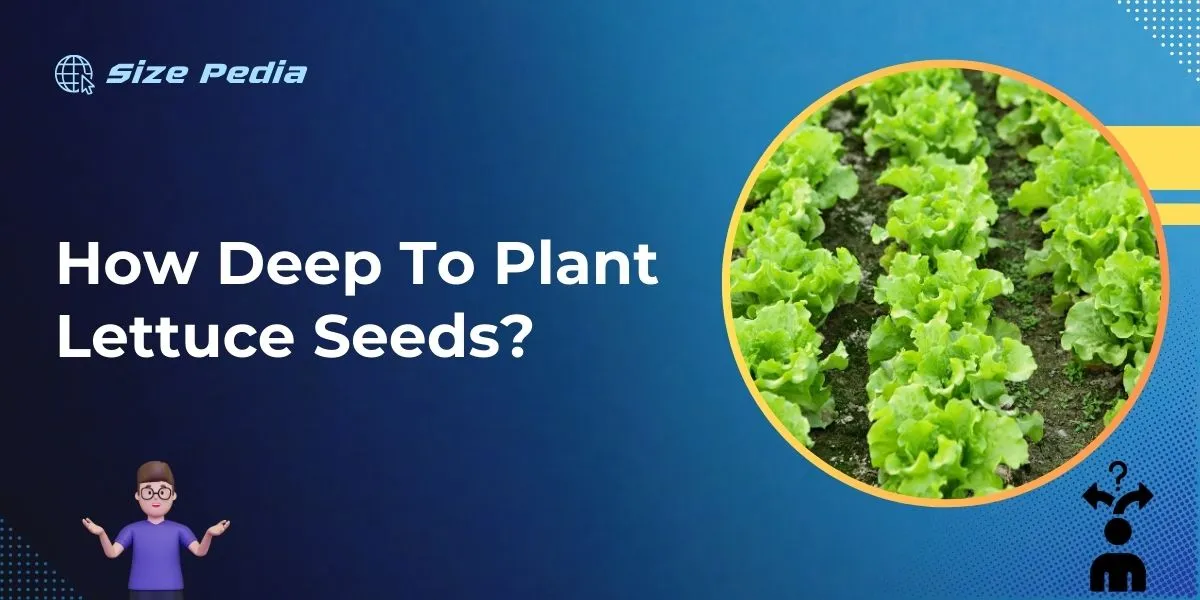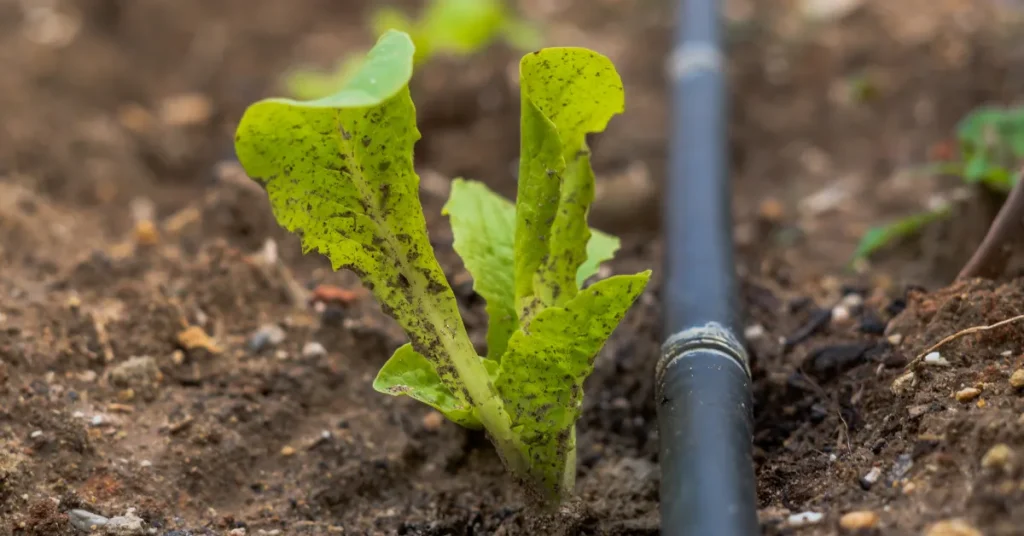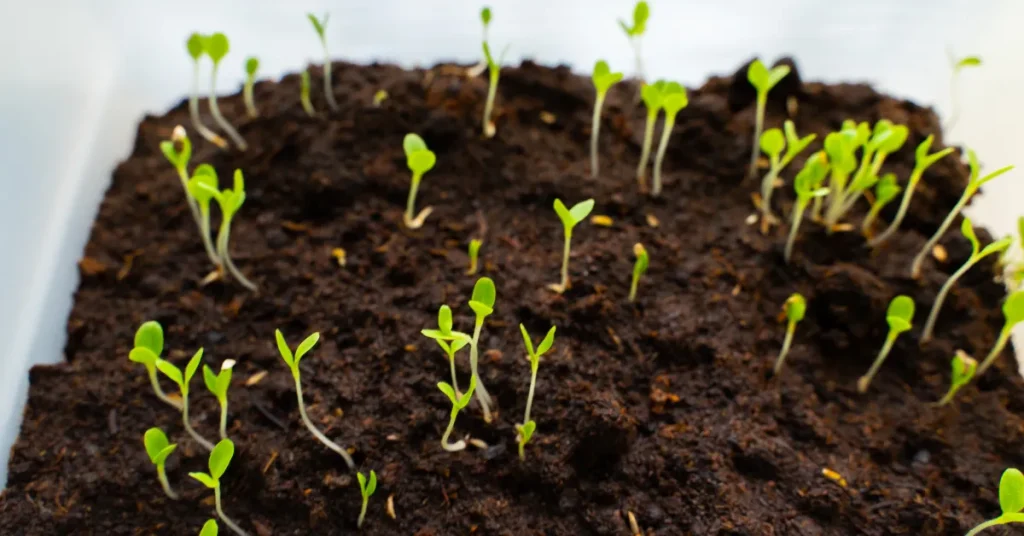Lettuce seeds should be planted about 1/4 inch deep. It’s essential to lightly cover the seeds with soil.
Growing lettuce from seeds is a practical choice for gardeners aiming to enjoy a fresh, homegrown salad.
These leafy greens thrive in cooler temperatures and can be cultivated in many climates. Beginners find lettuce an agreeable option, as it is relatively easy to plant and quick to harvest.
Starting your lettuce seeds correctly sets the stage for a bountiful crop. By maintaining proper depth, you ensure adequate soil contact without burying the seeds too deeply, promoting successful germination.
The key is to create a hospitable environment from the very beginning, considering the light soil coverage that lettuce seeds require to sprout effectively.

Getting To Know Lettuce Seeds
When you wish to grow lettuce, knowing about the seeds is key. It’s the first step towards a lush, green harvest.
Lettuce seeds are small but mighty, and understanding their needs is what leads to a successful garden. Let’s start by discussing the different varieties and characteristics of these seeds.
Varieties Of Lettuce
- Romaine: Tall heads, crisp leaves, great for Caesar salads.
- Iceberg: Crunchy leaves, perfect for a classic wedge salad.
- Butterhead: Soft, tender leaves, often used in wraps.
- Leaf Lettuce: Includes red leaf and green leaf, known for their loose arrangement.
Lettuce Seed Characteristics
Lettuce seeds are tiny and require a shallow planting depth. They need light to germinate, so pressing them into the soil surface is sufficient. The seeds should stay moist for germination. Keep them between 60-68 degrees Fahrenheit for the best results.
| Color | Size | Germination Time |
| Light brown to black | About 1/16 inch | 2-10 days |
Prepping Your Garden: Soil And Season
Before you sprinkle those tiny lettuce seeds into your garden, let’s ensure a bountiful harvest with some soil and season preparation.
Mastering the art of growing crispy, fresh lettuce begins below the surface. Finding the perfect balance in soil and timing is key for tender, leafy greens.
Soil Type And Preparation
The right soil makes all the difference for growing lettuce. Aim for a loamy, well-drained texture. Let’s get that soil ready:
- Test the Soil: It should have a pH between 6.0 and 7.0. Adjust as needed.
- Enrich with Compost: Mix in plenty of organic matter. This provides nutrients.
- Smooth the Beds: Make the ground flat. Lettuce roots spread wide and shallow.
- Moisture is Key: Keep the soil consistently moist. Not soggy, though.
A gentle start for lettuce seeds leads to strong growth. Make sure your soil is welcoming.
Best Seasons For Planting Lettuce
Lettuce enjoys cool weather. Your seeds will thank you if you plant during the right season:
- Spring Planting: Start as soon as the soil is workable. Frost is not a foe for lettuce.
- Fall Harvest: Plant about 6-8 weeks before the first fall frost. This gives lettuce time to mature.
By planting in mild temperatures, you’ll encourage speedy and healthy lettuce growth. Save the hotter months for the beach, not your lettuce!
Lettuce Planting Depth Considerations
Growing lettuce requires knowing just how deep to plant those tiny seeds. This may seem like a small detail, but it’s crucial.
Getting it right means a healthy start for your greens. In the following sections, learn about the optimal depth for planting and the different factors that can affect this aspect of growing lettuce.
Optimal Depth For Lettuce Germination
Lettuce seeds need light to germinate best. Because of this, they only need a very shallow covering of soil. The ideal depth is about 1/8 to 1/4 inch (0.3 to 0.6 cm). At this depth, seeds can still receive sunlight while keeping enough contact with the soil to stay moist.
- Too shallow, and they might be washed away or fail to root.
- Too deep, and they might not germinate due to lack of light.
Factors Influencing Seed Depth
Several factors can change how deep you should plant lettuce seeds:
| Situation | Adjustment |
| Heavy Rain Forecast | Plant slightly deeper to prevent washing away. |
| Very Fine Soil | Keep at 1/8 inch to ensure enough light. |
| Use of Mulch | Clear a thin layer before sowing. Plant at normal depth. |
Understanding your environment will help you make these small but important adjustments. Always aim for the balance between seed-soil contact and light exposure for strong germination.
Planting Techniques For Success

Mastering Planting Techniques for Success can mean the difference between a good lettuce crop and a great one. Lettuce seeds are dainty, needing careful handling.
With the right depth and approach, a thriving lettuce garden is just a few weeks away. Follow these simple methods to get started.
Broadcasting Vs. Row Planting
Choosing how to plant your lettuce seeds is crucial. Let’s explore two popular methods:
- Broadcasting is scattering seeds over the soil surface. It’s fast and easy. Perfect for a casual garden look.
- Row Planting involves planting seeds in straight lines. This method allows for easier maintenance and harvesting.
To plant lettuce seeds, prepare a smooth seedbed. A light sprinkle of seeds either way should work. Make sure seeds are no deeper than 1/4 inch in the soil. Lightly cover them with soil or compost.
Watering After Planting
After you tuck the seeds into their soil bed, watering is next. Lettuce seeds need moisture to germinate. Here’s your simple guide:
- Use a gentle spray to avoid disturbing the seeds.
- Keep the top inch of soil moist, not soggy.
- Water often until the seeds sprout. Then, you can reduce the frequency.
Mind the weather, as hotter days may require extra water. Consistent moisture gives lettuce seeds the best start.
Caring For Your Lettuce Seedlings
After planting lettuce seeds just below the surface, it’s time to look after the little sprouts. Proper care ensures your lettuce grows healthy and delicious. Let’s walk through the steps to nurture your seedlings.
Thinning Seedlings
Thinning is crucial for growth.
- Start when seedlings have several leaves.
- Choose the strongest; remove the rest.
- Space them out about 4 inches apart.
This gives each plant enough room to thrive.
Mulching And Fertilizing
Mulch keeps soil moist and weeds away. Apply a thin layer around your plants. Use organic mulch like straw or grass clippings.
Fertilizing gives your plants an extra boost. Use a balanced fertilizer when the plants are a few inches tall. Follow the package’s instructions.
Troubleshooting Common Issues

When you plant lettuce seeds, you might face issues that stop them from growing well. This part tells you how to solve these problems.
Dealing With Poor Germination
Lettuce seeds need light and the right temperature to grow. If they don’t germinate, check these things:
- Soil Temperature: Keep it between 60-70°F (15-21°C).
- Light Exposure: Don’t bury the seeds too deep. Just a light cover of soil is enough.
- Watering: Soil should be damp but not flooded.
- Seed Age: Use fresh seeds for better results.
Protecting From Pests And Diseases
Lettuce can get sick or attacked by bugs. Check these tips:
| Action | Benefit |
| Use row covers | Keeps bugs away |
| Rotate crops | Prevents disease buildup |
| Choose disease-resistant types | Reduces risk of sickness |
| Water in the morning | Leaves dry out, less mold grows |
Check plants often for early signs of trouble. Look on leaves for spots or bugs. If you find something wrong, act fast to fix it.
FAQs About How Deep To Plant Lettuce Seeds
What Is The Ideal Depth For Lettuce Seed Planting?
Lettuce seeds require shallow planting, typically around 1/4 to 1/2 inch deep. This allows for sufficient light exposure which is crucial for germination. Ensure that the seeds are lightly covered with soil for best results.
How Does Seed Depth Affect Lettuce Germination?
Planting lettuce seeds too deep can hinder their ability to germinate. Proper seed depth ensures adequate light reaches the seeds, which is essential for the germination process of lettuce. A shallow depth maximizes germination success.
Can Lettuce Seeds Germinate On The Soil Surface?
Lettuce seeds can germinate on the soil surface as light aids their germination. However, they should be lightly covered with soil or vermiculite to maintain moisture and protect them from being washed away or eaten by birds.
Should I Soak Lettuce Seeds Before Planting?
Soaking lettuce seeds is not necessary. Lettuce seeds are small and germinate quickly when sown at the correct shallow depth and kept moist. Over-soaking can damage the seeds, reducing germination rates.
Conclusion
Planting lettuce seeds at the proper depth sets the stage for a bountiful harvest. Aim for a quarter inch to ensure optimal growth.
Remember, success lies in the simple details. Keep soil moist and anticipate sprouts in 7 to 10 days.
Ready your garden, for fresh salads await!
Resources:
1. https://extension.umn.edu/vegetables/growing-lettuce-endive-and-radicchio
